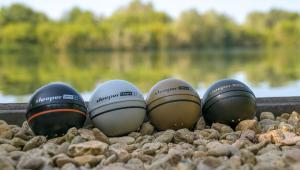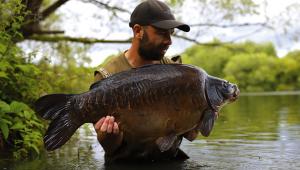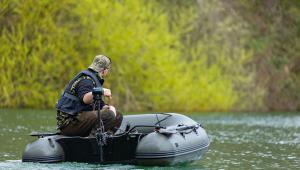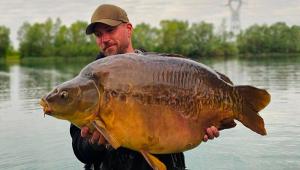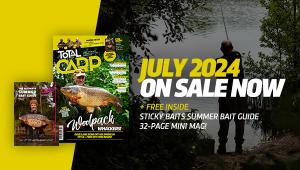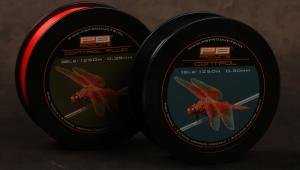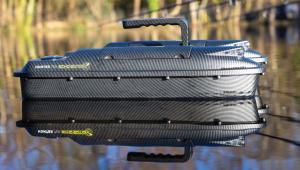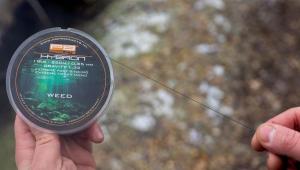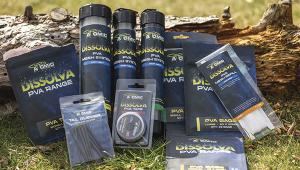Winter Is Coming
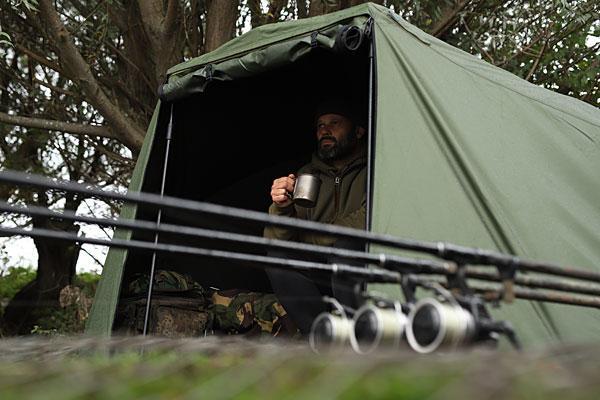
As we’re going to talk about the transition from autumn angling into the winter. I would say one of the major things that I would be looking for at this time of the year on the transition is weather. You want to be looking at long range weather forecasts and using that information to plan your trips if you can, and at this time of the year you notice that the carp are going to be using a lot of different areas as to what they would’ve been using in the spring and summer, so you start to see a migration of fish from using the marginal areas and the shallows, to the deeper and silty areas and the troughs, for a number of reasons.
Firstly, there’s going to be a temperature change coming in this time of the year. The longer nights and the cooler days are going to mean the water temperature drops and the first noticeable areas of the lake are going to be the shallower areas of the lake. Second reason that we can also be looking at there is once the weed starts to drop due to the lack of daylight hours, the natural food starts to come from the shallows and the weed rich areas of the lake and it’ll migrate to the dirtier/ siltier areas of the lake and obviously the autumn is a harvest time for the carp and they’ll follow the natural food for that harvest and they’ll start using areas of the lake that you might not have seen them in for months, hence why you’ve got to look carefully at temperatures, wind directions and all those factors that will make your decision as to where you’re going to fish.
The other thing that we’ll also need to talk about is the shows. Come spring/summer you might be seeing shows from first light through till breakfast time and then you can go walk around the lake and generally find them basking in the weed beds… that’s not the case in the autumn! Quite often, as October/November and the colder months move in, sometimes the only time you’re going to see those carp is in the hour of darkness and that’s a really important factor, to be really vigilant throughout the dark hours as much as you possibly can really. That may mean going to bed a little bit earlier and setting your alarm for 1am/2am and just having one of those late nights where you sit up and might have a few cups of tea, just listening and watching carefully over the lake and quite often that will help you give yourself the best chance of locating those carp whereas you can spend all day looking and not see a single sign. So, weather dependent and temperature dependent plus the switch from daylight hours to night time shows are incredibly important aspects of carp angling at this time of the year.
Obviously the weather is getting colder, the nights are getting longer and wetter as well as the winds getting colder, so you need to keep the comfort levels up at this time of the year. I’ve spent many of winter in the past huddled under a 60in brolly and it doesn’t really do the best for your health. These days I’ve got an overwrap for my brolly or a nice comfortable bivvy just so I can keep out of the wind; if say, the wind changes direction or you get a big storm come in with driving rain, you can get yourself out of it and keep comfortable.
There’s nothing worse than at late autumn/early winter than getting wet at the start of your session or going through a couple of spare sets of clothes, because once you’re uncomfortable you do not want to be there and you’ll end up fishing inefficiently and you’ll want to go home. I tend to move over with the cold weather to a petrol stove/Coleman as it suits me. It’s cheap fuel and very reliable in the cold weather, that’s another little tip.
Also make sure you take plenty of good sustenance/good food to cook on the bank as we move into winter as well. It’s all revolving around comfort levels and that little bit of extra kit that you might take is definitely worth investing in. You might be able to get away with it on short overnight sessions in the summer or spring but when you’re coming to do a few nights in the winter you definitely want to utilise that time on the bank effectively. It’s always worth having some spare clothes in the van and a good set of waterproofs with a good base later and warm jacket underneath along with some salopettes ideally, so that covers that aspect of the approach.
The next thing I think we ought to look at is carp location in the winter. By this I mean what else are we looking for? What could we fish to and why do they go to these particular areas? In the winter you need to look at structure and features in the lake. It’s really, really important if you’ve got a lot of timber work and sets of snags that quite often, once the weed’s dropped at this time of year, the carp will move to those snaggy areas especially if they’re deep. Carp love cover over their heads and they also love structure, so big steep bars, plateau areas and snaggy corners out of the wind are really important areas to look at when it comes to locating carp in winter.
If you’ve got a lake that’s got no weed in it or it’s died back, the middle of the lake is also another area which the fish will migrate to. The centre of the lake is a winner when it comes to winter location so that’s a point worth bearing in mind.
If you haven’t quite located the carp visually, another really good way of trying to find their whereabouts is to fish for liners; ie. spread your rods out over an area of a swim for a few hours, tighten the lines up and just have a little drop on the bobbins and let that line sag out through the swim onto the spots. Look for the signs and search out for those little bleeps/subtle liners that you might get as the carp move around the swim. Sometimes they can be the one and only location aid that you might have for that period of time and quite often they don’t always go that far. That little bit of information could set you up for the rest of your winter campaign so it’s a very important thing to do.
Rigs And Bait
For many years I generally tended to use a very similar style of rig that I was using through the spring and summer, a bog standard hinge rig or wafter style bottom bait for fishing over bait. However, over the last few years where I’ve moved around more from water to water, quite often it’s nice to have a particular rig that you’ve got a lot of faith in throughout the winter almost like a take-anywhere rig and the one that I’ve come up with that seems to work everywhere and has done me proud over the last few years. It’s a really straightforward rig, it uses a semi-stiff coated material, a small sharp hook with an extended shank with a bit of shrink tube line aligned so it flips and turns really, really quickly. I then put a hook bead on the hook along with a micro ring swivel and it means I can then fish that rig with the bead around the bend with a bottom bait on, a small stack of maggots or if I want to use a little dumbbell/wafter I can just move the bead back round the shank towards the eye so the hook acts like a claw once again.
If you also want to fish it on a pop-up, all you do is put a small shot on the coated braid and you can fish it with a pop-up. It’s extremely versatile, it allows you to use little mesh bags of crumb to cast at showing fish and you don’t have to worry about rigs then, so you can channel all your focus on location.
The last really important factor to consider in winter fishing is your baiting strategy. In the past I’ve done winters using just boilies, I’ve done a full winter on naturals, ie. maggots/casters and I’ve fished them purely on particles too. They’ve all been successful in their own right at some point, but I’ve found that these days by using my years of experience at fishing through the many winters the best approach is using boilies but breaking the structure so than it being a sealed unit, I actually crumb and grind it into a powder and leave some larger chunks with a few smaller whole ones, but the most important part is that you break that structure down.
Firstly that allows ingress of water and egress of your liquid attractors into the water column much more quickly than a solid bait, and it’s never more important than when the water temperature is cold as you’ve got to remember that these baits have been bound together and boiled, so by breaking them open and crumbing them you’re allowing maximum attraction in the cold water temperatures, and that’s incredibly important.
The second and even more important part of it than that is you’re allowing the bait to soften and break down and it becomes infinitely more digestible to the carp once they start consuming it in the colder temperatures as their metabolism slows right down and their ability to break down the baits through their gut is much reduced, therefore you need to give them as much help as possible. So boilie crumb and broken boilies are the mainstay of my approach and to that I will either add an amount of easy-to-digest pellets (I particularly like the bloodworm pellets in the winter). I’ll also add an amount of particles. That might either be salty maize, a small around of hemp or groats.
I really like groats; one thing we may touch on is that naturals such as maggots are incredibly effective in the winter but I’ve noticed over the last few years that more and more fisheries are limiting or banning their use altogether, so if that is the case, groats are a fantastic particle to use as visually they’re almost like a little maggot, they’re highly digestible and they give off a lovely creamy liquid, so for the winter they’re always a particle I wouldn’t hesitate in throwing into the mix. You don’t need to use loads but they’re ever so cheap and are highly effective.
And really... that’s about it! Small items, feed regularly and another quick tip before I leave you to it, is if I do see activity over the area, I use a mini Spomb as it allows me to put a small amount of bait over the top of the fish and get away with it quite easily as it makes minimal splash and I’m only putting out tiny amounts of feed and that’s what you want. Little and often in the colder months is often the key and consistency with your baiting once you’ve found fish is a priority.
If you can get to the lake maybe a couple of times a week after dark and just add a little bit of food to your area without disturbing other anglers, that’s always a massive edge. Once the food stops going into spots during the winter the fish are quite hard to re-stimulate to start their feeding activity once again.
Step-By-Step: Tying Oz' Winter Rig
1. Strip off a length of Semi Stiff coated braid.
2. Strip a couple of inches of coating.
3. Whip on a curve point hook with a knotless knot.
4. Thread on a mini hook ring swivel, followed by a bead.
5. Pierce a length of shrink tube, line aligner style.
6. Position it like so on the hook to extend the shank.
7. Thread on a Tungsten dropper…
8. … followed by an anti-tangle sleeve, before tying your loop.
9. Steam the rig and shrink tube.
10. Finally mount your chosen hook bait on to the hook ring swivel.
- Log in or register to post comments
